

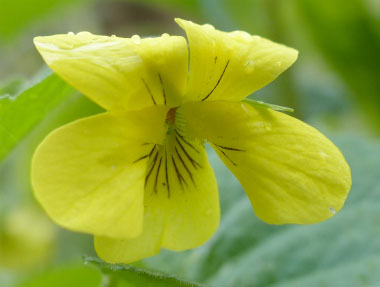
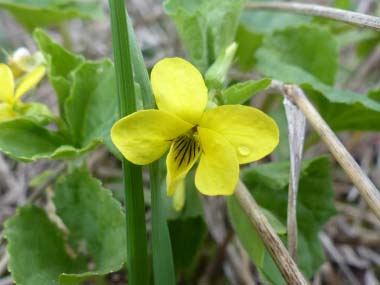
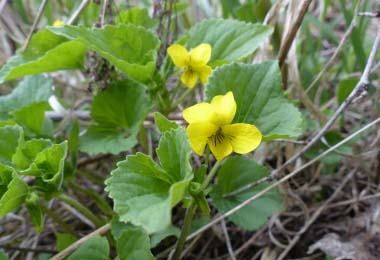
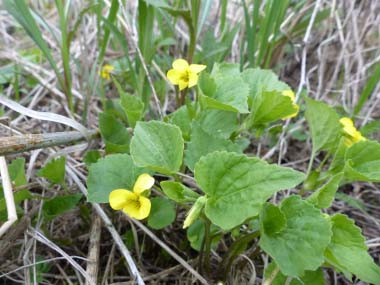
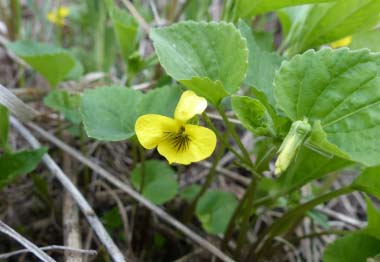
To support our efforts please browse our store (books with health benefits, etc.).
The Downy Yellow Violet is divisible into two varieties which may be distinguished as in the following key.
1) Plants moderately to thickly hairy, bearing 1-2 flowering stems and 0-2 basal leaves (Viola pubescens var. pubescens)
2) Plants hairless or almost so, bearing 3 or more flowering stems and 1-3 or more basal leaves (V. pubescens var. scabriuscula)
The nectar and pollen of the flowers attract primarily bees and less common insect visitors include small butterflies and skippers.
Distinguishing Features
This is a soft hairy violet that can reach up to 9-12” tall. The bright yellow flowers, veined with purple or brown toward the throat, grow on leafy stems above sturdy green foliage. Among the numerous yellow violets, the hairy nature of this species is usually distinctive.
Flowers
Flowering is from early May (or rarely the last week of April) through June. Flowers are about ¾ inch across, 5 yellow petals with several purple or brownish lines on the lower petal. The side petals are bearded with short hairs on the inside near the base. The flower is at the end of a stem that arises from a leaf axil. One plant can have several flowers.
 Fields
of Nutrition has medicinal benefits and vitamin/mineral content of Downy Yellow Violet.
Fields
of Nutrition has medicinal benefits and vitamin/mineral content of Downy Yellow Violet.
Leaves
This plant has basal leaves, growing alternately on the stem. Basal leaves are broadly heart-shaped, to 3” wide and 2½ “ long, with coarse teeth or scalloped edges and hairy leaf stalks about 3” long. The stem leaves are a little smaller, more elongated than broadly heart-shaped. The undersides of leaves are usually covered in short hairs but may be smooth.
Height
Depending on growing conditions the downy yellow violet can reach up to 9-12” tall.
Habitat
This native violet is common in nearly all areas of central to eastern Canada and U.S. It also grows in the temperate regions of Europe and Asia. Habitats include moist to mesic deciduous woodlands, woodland borders, and thickets. Interestingly, it was once cultivated in Europe for the purpose of detecting an acid or alkali.
Edible Parts
Flowers and leaves are edible. The root has been used in the past for medicinal purposes.
Other Name
Yellow violet.
Similar Plants
Common violet, White violet.
Winter Survival Food Handbook

PDF Plant Magazines
Types of Wild Food
Geographic Zones Seasons
Disclaimer
EdibleWildFood.com is informational in nature. While we strive to be 100% accurate, it is solely up to the reader to ensure proper plant identification. Some wild plants are poisonous or can have serious adverse health effects.
We are not health professionals, medical doctors, nor are we nutritionists. It is up to the reader to verify nutritional information and health benefits with qualified professionals for all edible plants listed in this web site. Please click here for more information.
Why Edible Wild Food?
- Food costs are rising
- Free, wild food is readily abundant
- Wild food adds nutrition to your diet
- Wild food can help treat various medical conditions





